Table of Contents
Oh boy, beekeeping can be confusing getting into beekeeping. I remember when I was there, I’ve still got the notebook that is full of all the questions I had before I opened my first hive.
What is a brood box? How many supers do I need? What is a super? It was hard to understand what was what, and asking questions to local beekeepers made it more confusing. And don’t get me started on forums…
But I’m here to help you. When we talk new beekeepers to customers in our store and on this website, we do our best not to use the complex jargon that is so common in beekeeping. But in this blog post, we will break it down and make it easier for you.
In the United States, more than 90% of beekeepers use the Langstroth Hive for the beehives. This hive is common in the US but not in other parts of the world.
Other parts of the world use different types, but many are similar. They are usually squarish boxes with frames in them that you stack on top of each other. So that is where we will land here, so let’s explain.
Bees Live In A Cavity
A colony of bees are cavity dwellers; this means they can live in nearly any size of the empty cavity. It could be a tree, inside a wall in a house, or an abandoned grill.
You get the point. These bees live in these cavities, and they don’t really care what the shape of it is, as long as it is large enough for them to live.
As beekeepers, we made these wooden or plastic boxes for the bees to live in. Inside these boxes, the bees function just like any other void. But beekeepers made boxes small enough to take apart “easily” to inspect the colony.

Common Types of Bee Hives (with Handicap Accessible Options)
There are many types of beehives available from the most popular Langstroth to the skep, and Warre hive. We will explain the differences.
If the beekeeper used one giant box that is 5 feet tall, they couldn’t take it apart without destroying the colony. This is why Skep hives aren’t used anymore. If you don’t know, skep hives are those upside-down basket-looking bee hives.
The boxes are made to fit the beekeeper, not the bees. But the bees are pretty flexible and will live in any void.
So these boxes come in different sizes, both in height and in width. This is also to fit the beekeeper and how they want to keep bees.
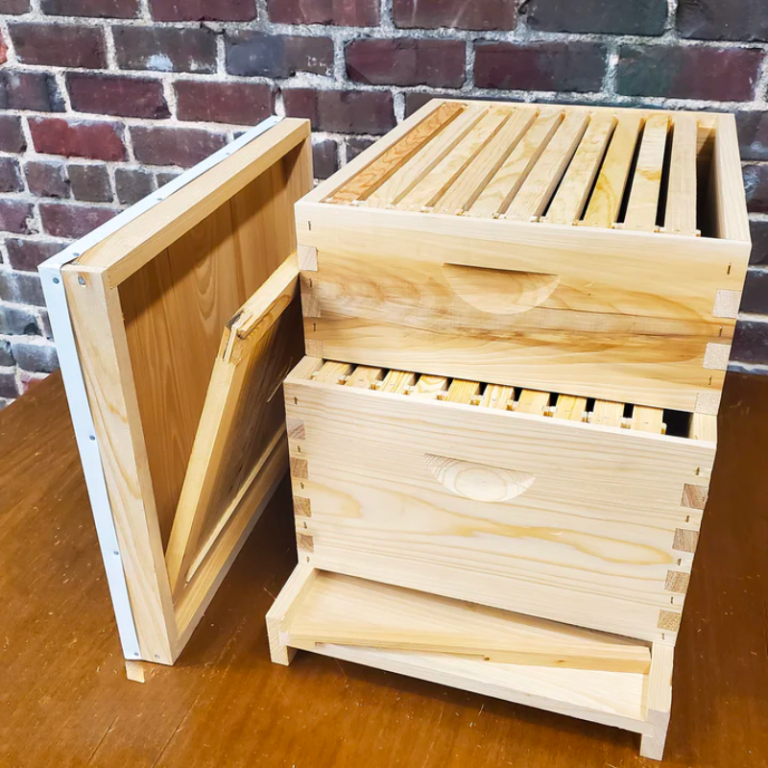
Types of Boxes
The varying sizes of boxes all have different names. I like to keep it simple, so the only beekeeping terms I typically use to describe them are 10 frame, 8 frame, 5 frame, deep box, medium box, and shallow box.
These 6 terms include all the sizes most US beekeepers use. All of these size boxes can be used by the bees to do anything they want. They can raise brood, and queens, collect pollen and store honey in every size here.
10 Frame Box
These hold 10 frames in them and come in deep, medium, and shallow sizes. These are the most common size and also the heaviest because they hold the most frames.
All 10 frame hive equipment must pair with other 10 frame equipment.
8 Frame Box
These boxes hold 8 frames in them and come in deep, medium, and, very rarely in, shallow boxes. These are less common but are becoming very popular because they are less weight and easier to handle than a 10 frame hive.
8 Frame equipment is a good choice for many backyard beekeepers.
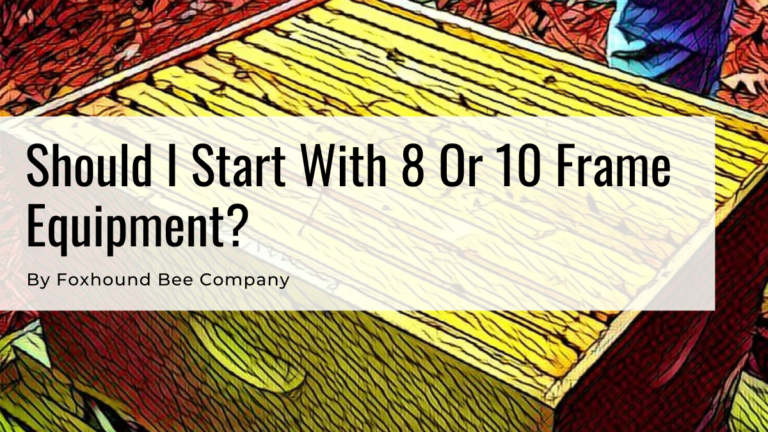
Should I Start with 8 or 10 Frame Equipment?
Choosing the right beekeeping equipment for you is important. What works for another beekeeper, may not work for you. It’s important to understand the ins and outs
5 Frame Box
These boxes hold 5 frames in them and come in deep and medium sizes. We have never seen them in a shallow size. 5 frame equipment is typically just a temporary hive used for capturing swarms, dividing a colony, or selling a small colony.

Should I Start With All Medium or Deep Boxes?
As a beginner beekeeper, there is so much to learn prior to keeping bees. Starting to keep bees requires a lot of upfront decision-making. Some
Deep Boxes
These are also called brood box, brood chambers or deep hive body and are 9 5/8 inches tall. They are available in 10, 8, and 5 frame sizes and are most often used as a place for the queen to lay eggs.
These boxes store honey and can be used for the bees to store excess honey in, but honey is very heavy, and because this is the biggest box, it is not usually used for storing excess honey. When full of honey, they can be over 100 lbs.
Medium Boxes
A medium box is most commonly called a honey box or honey super, or simply super, and is 6 5/8 inches tall. They are available in 10, 8, and 5 frame sizes and are used as both a place for the queen to lay eggs and also for storing honey for the bees and excess honey for the beekeeper.
The reason these are used for harvesting honey is that they are lighter than a deep box of honey. Even though they are lighter, they are still around 40-60 lbs.
Shallow Boxes
A shallows box is a size box that isn’t used very much anymore. It’s so rarely used that we don’t even sell them anymore. They aren’t popular because they are 5 5/8 inches tall, which is very close to a medium box.
They are so close in size to each other that beekeeper just started using medium boxes because they can hold more honey and are not that much heavier than a medium box.
When a customer comes into the store and is looking for shallow equipment, it is nearly always because they bought a pile of equipment used or they were given the equipment by an old beekeeper.
Shallow boxes were used mostly by older beekeepers because they started keeping bees before medium boxes were even invented.
Brood Boxes
Brood boxes or a brood chamber doesn’t really describe the size of the box (though many beekeepers use the term that way); it describes what the bees are doing with it.
Beekeepers often use the term brood box or brood chamber when discussing deep boxes because that is what they are usually used for.
The brood is the nursery of the hive, so that is the place you will find the queen, eggs, larva, pupae, and other parts of the brood nest. The size of the brood nest will change based on the location of the hive.
Beekeepers in Canada need a hive with a larger brood nest (ie more boxes) because the colony has a longer winter to survive than a beekeeper in Miami.
So a beekeeper in Minnesota may have a brood nest that is 2 deep boxes or 3 medium boxes and this is what the bees will be in when winter starts. A beekeeper in Texas may be just fine with 1 deep box or 2 medium boxes when winter starts.
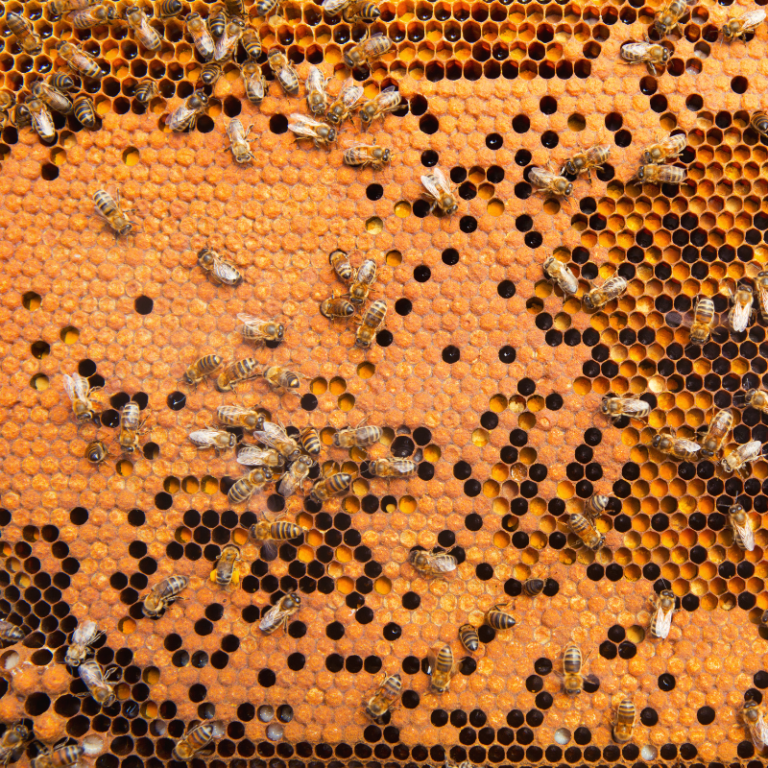

Honey Boxes
Much like brood boxes, honey boxes can either be a deep or medium box. They can also be shallow boxes if that is what the beekeeper uses.
Because a deep box is so heavy when full of honey, a deep box is only used for honey production in commercial operations when efficiency is more important than the backs of their employees.
When talking about honey boxes, nearly all beekeepers are talking about medium boxes and sometimes shallow boxes. So if you hear honey box or honey super, they are not talking about a deep box (usually).
What is a bee super?
We have a separate blog that talks about what a super is and where that term comes from. Putting it simply super is short for the superstructure because the Langstroth hive is stackable, and the size of the hive changes depending on the time of the year.
The part of the hive that the bees live in year-round (brood boxes or brood chambers) is the structure.
When the boxes (typically medium boxes) are added to the hive during the honey flow or nectar flow, they are the superstructure (supers).
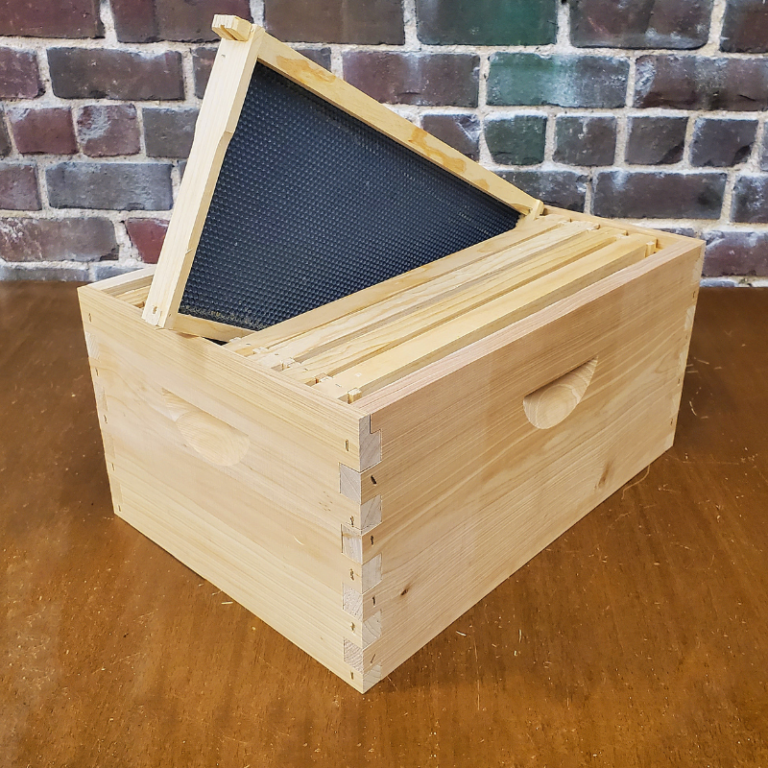
Bee Frames
Frames are slightly easier to understand (usually). There are variations for each, but all most beekeepers use either deep frames, medium frames, or shallow frames.
Their size matches the boxes they go in, and they are not interchangeable. Even though a medium frame can fit into a deep box, you must use deep frames in a deep box.
The size of foundation that goes into the frame is dictated by the size of the frame. So the size of the foundation will change as well as the type of foundation used.
The two most common types of foundation is beeswax coated plastic foundation and pure beeswax foundation.
365 Day Hive
At Foxhound Bee Company, we have a term we use to help beginner beekeepers understand the general flow of beekeeping throughout the year.
I didn’t understand it when I started, so we teach it to our customers. The colony lives in the boxes, and the colony’s size expands and contracts through the year.
The colony’s size tracks the weather; it’s the largest in the summer and the smallest in the winter.
When hives are coming out of winter, a full-size colony is usually 2-3 boxes (the 365-day hive). The hive is expanding into spring and will need more room soon.
During the spring and summer, the colony needs the most space and the largest cavity this time. So this is when most beekeepers add honey supers and frames, usually 2-4 boxes. In these boxes, the bees store their excess honey.
Once the beekeeper goes out to harvest honey during mid-late summer, the beekeeper will remove the surplus honey boxes that were a part of the bee’s excess honey production.
The honey boxes removed are not put on until the following year, leaving the colony with it’s 365-day hive again. And this is what they go into winter with and is usually 2-3 boxes.
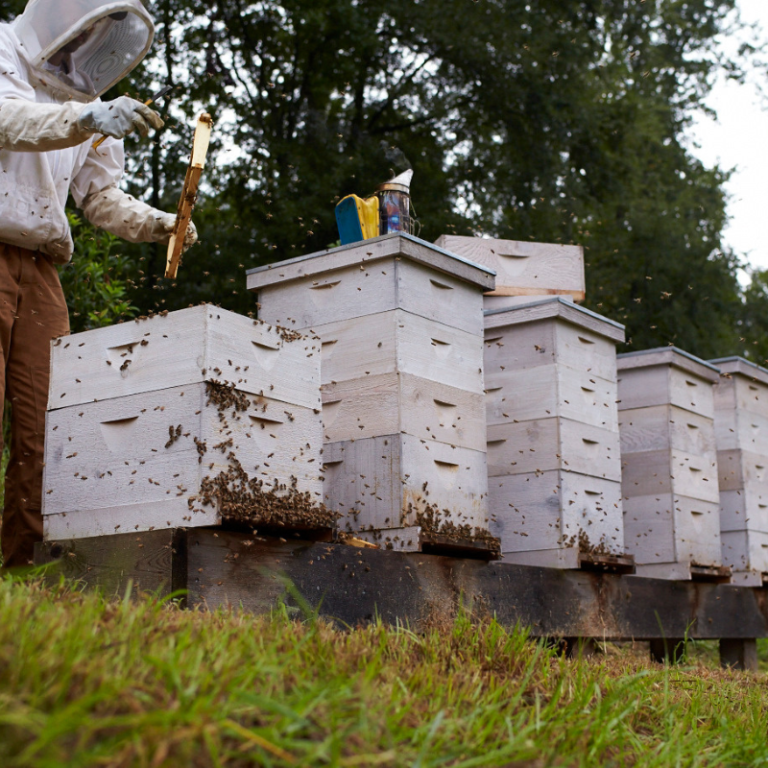
FAQ On Bee Boxes
What is the difference between a brood box and a super?
The brood box is where the queen is laying eggs and where the brood nest is. The super is where excess honey is stored by the bees. Or it could be describing a deep box and a medium box.
What is in a brood box?
The brood box has the queen, nurse bees, comb, bee bread (fermented pollen), some honey, larva, eggs, and pupa.
When should you put a super on a hive?
Beekeepers should add honey supers, or medium boxes to the hive when the nectar flow starts or just before it starts. Additional boxes should be added to the hive before the previously added honey super is full.
What is a brood box used for?
A brood box (deep or medium) is used as a permanent box for the queen to lay eggs year-round.
What is the difference between a brood frame and a super frame?
A brood frame is a frame that the queen has laid eggs in, and they are raising brood. It is usually a deep frame but can also be a medium frame. A honey super frame is a frame in which the bees store excess honey in, which is typically a medium frame.
Should I have 2 brood boxes?
Regardless if you use deep boxes or medium boxes for your brood chamber, 1 box is typically not a large enough brood chamber for a hive. The exception would be a sub-tropical environment or a beekeeper that is very closely monitoring their hives for growth. A 2 box brood chamber is more common and a better option for most beekeepers.
How much honey do you get out of a super frame?
One medium frame of honey will vary in how much honey it will hold, but one medium frame of honey will yield about 4.2 lbs of honey. See our honey calculator for more details.



